

With France out of the way and enough space to run a full-sized civilization, I could finally get back to the religious aspect of this game, which had been put on the back burner during the previous struggle. Here was a Turn 100 overview on the same turn that France was eliminated:

The Khmer territory was centered around a long V-shaped river valley that connected my original capital to the former French territory. I had either built or was in the process of building a Holy Site district in every city, and that was generating a healthy amount of faith for this date on the calendar. This was about double the faith/turn that I had been producing on Turn 100 in my previous two religious games, and I took that as a good sign. For a religious game, the total faith output is the most important metric of progress to track. The lengthy river winding through my territory also allowed virtually every Holy Site district to be placed next to the water, therefore scoring the unique Khmer bonus to food and housing. Since I had a heavy incentive to build aqueducts as well, I was skipping granaries in nearly every city, letting housing flow in for free from my Holy Site and Aqueduct districts. Conversely, science and cultural output were mediocre for a civ that had captured six cities from a rival empire, and my gold/turn income was downright sad. I had only a single Commercial district finished, zero Harbors or any cities on the water, and just one trade route in operation. This is where I could make some kind of quip about how material wealth is irrelevant when following the Noble Eightfold Path of Buddhism. In actuality though, it was a case of not being able to do everything at once and having to make tradeoffs. I was playing the religious game and that meant sacrificing in other areas. It would be dozens more turns before I built even a single Campus district.
When I checked the scoreboard on this nice even date, I was slightly behind Gorgo at 213 to 202 points, and the rest of the AIs were clustered around 160 points. It was good to know that I was right there with the score leader, although it was a bit concerning that Gorgo had so much military power and disliked my civ intently. She can be a tough AI leader to stay on good terms with, between her fondness for large armies and Greece's role as a cultural powerhouse.
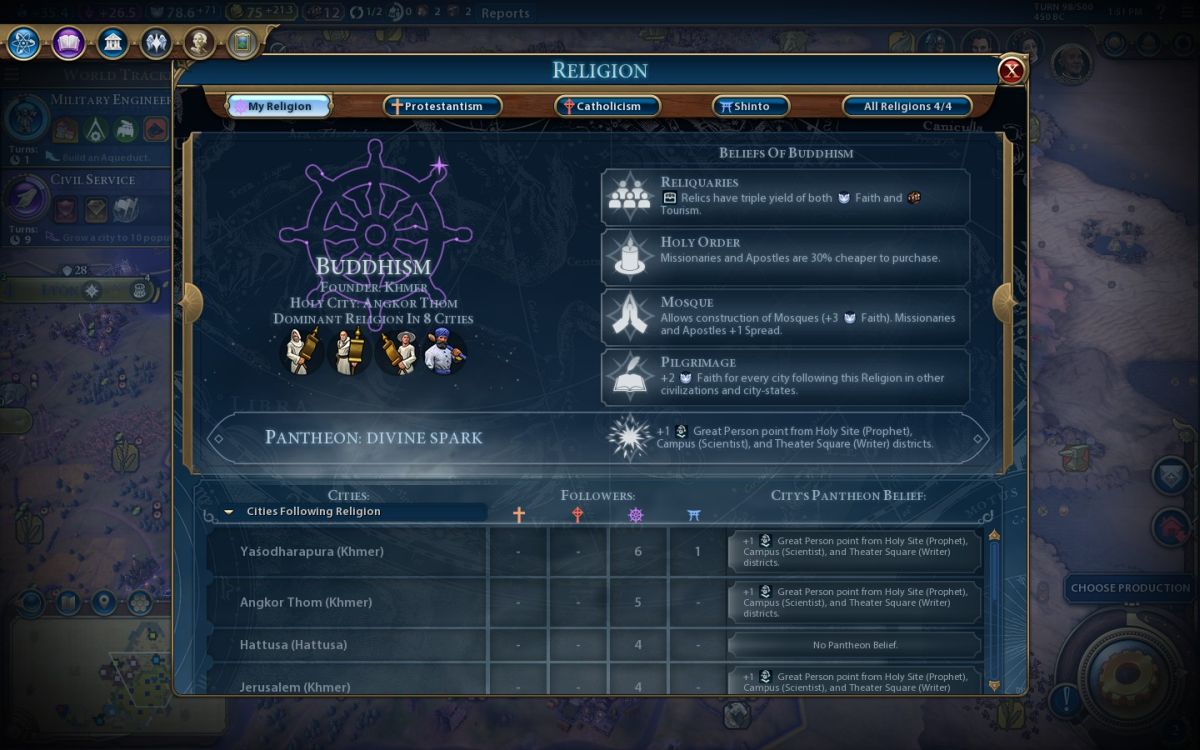
A little bit earlier, I had accumulated enough faith to purchase two apostles and enhance my religion. I was building the Mahabodi to get two apostles for free, and I would land that wonder a little bit later, but decided to go ahead and enhance my religion anyway before the wonder finished. If you're going to be playing a religious game and purchasing lots of apostles over the course of the game, it's better to go ahead and enhance your religion immediately to start enjoying the benefits of the enhancements at an earlier date. Taking Mosques for the worship building slot was an obvious choice, as the extra religious spread charge on missionaries and apostles makes it enormously easier to do the mass converting necessary to achieve the religious win. The Founder belief was a little bit more complicated, and I think that's the weakest of the four belief types by a wide margin. I decided on Pilgrimage in the end because this was one game where there would be plenty of Buddhist cities in other civs. In general, I think Church Property is normally the best option there with its +2 gold per city following your religion. Everything in that category is underwhelming though; I wish that I could take more of the powerful Enhancer beliefs instead.
The following turns were relatively quiet, with my cities continuing to accumulate faith production before setting loose a flood of missionaries. It made no sense to purchase any of them until I had at least one Mosque finished for the extra spread charges, and that meant some quiet turns here while building the structures. I also met the remaining AIs who had been located in distant lands in the past. Harald of the Vikings turned out to be located immediately west of France:
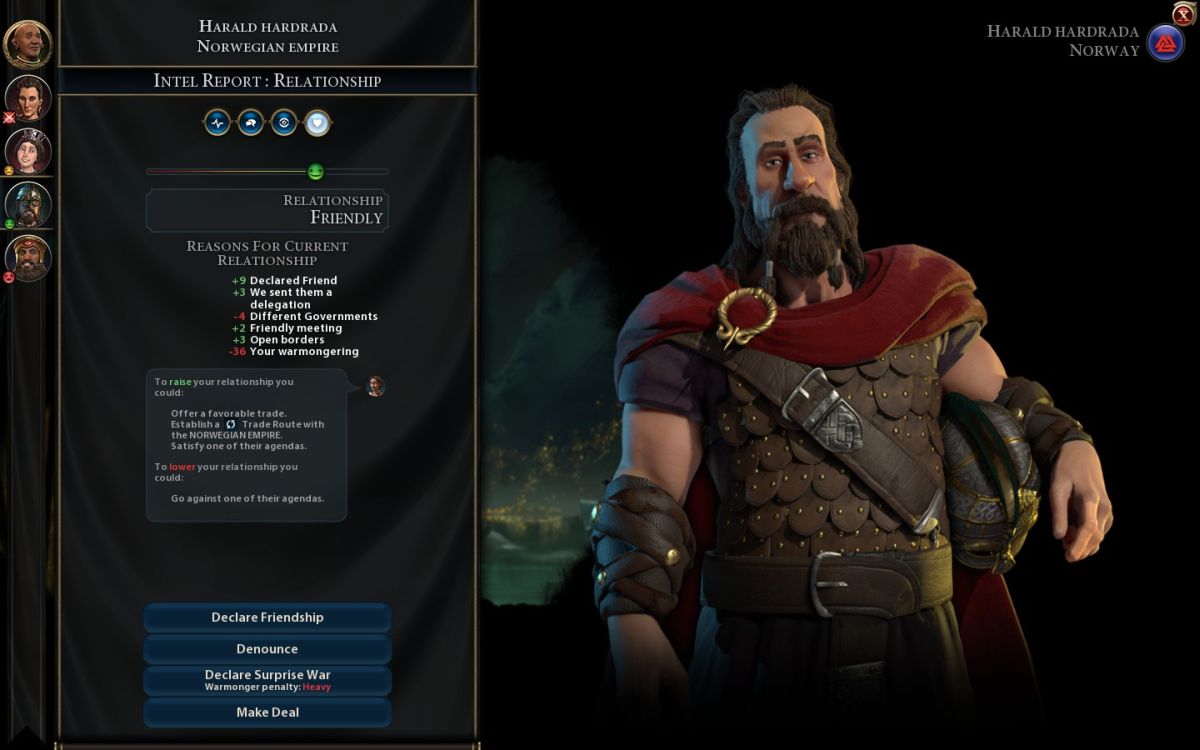
We had met some time earlier, although I hadn't had a clue where his territory was situated until after France was gone and I could send a couple of units out exploring. The two of us were on good terms at the moment in spite of Harald's Catholic faith and I was able to get a Friendship agreement signed, although it was obvious that wasn't going to last forever. My elimination of France had left my civ with an enormous warmongering penalty, and that would act like an anchor to drag down relations with other other leaders. Despite the fact that the warmongering penalties have already been toned down repeatedly, I still feel like they're set too high. It's a little bit silly that attacking another leader after the early stages of the game makes the player an instant pariah, when the AIs will happily war with one another all day long. Well, I guess in this case I did deserve this reputation, hitting France and signing peace and then hitting them again as soon as the treaty wore off. Jayavarman had not been a trustworthy character, and the AIs were right to view him with skepticism.
For some reason I had forgotten that I selected the Continents map script, and it came as a surprise when I realized that the last two AIs, Victoria and Gilgamesh, were both located on another landmass. I have no idea how that happened, absent-mindedness on my part. Victoria must have needed horses badly, as she was willing to pay me 12 gold/turn for a single excess source of mine. Sold! Gilgamesh was the Stonehenge builder from the early game, and he had converted all of the cities on his continent to Protestantism. Three of the four religions in this game had appeared on my continent, which I'm not sure was a good thing or a bad thing. It was going to take some time and effort to get missionaries over to his lands. (The religious choices in this game were really weird, by the way. Gilgamesh built Stonehenge and randomly chose Protestantism, which blocked Harald from his normal Protestantism, so he took Catholicism and that blocked Catherine from taking it, so she picked Shintoism. Strange stuff.)
Meanwhile, as for Gorgo:
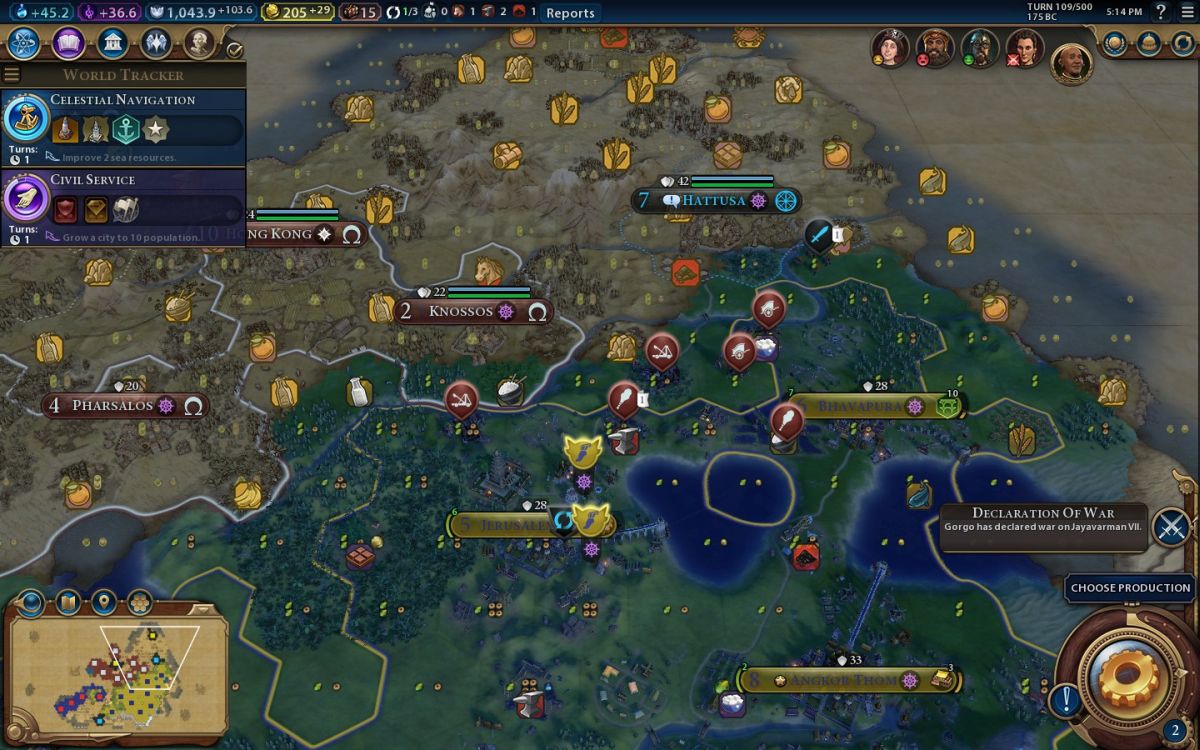
She had been telegraphing a war declaration in the most obvious way possible, moving a series of units along my northern border for about a half dozen turns before finally pulling the trigger. This had given me time to prepare accordingly, upgrading my archers to crossbows and moving them back across my territory towards the threatened cities of Jerusalem and Bhavapura. Earlier in the game, I had running the Strategos policy card in the Wildcard slot to make some progress towards a Great General, thinking that it would be really helpful against France. I didn't get that Great General in time to use it against Catherine, but it left me close enough that I could faith-purchase the remainder and now deploy the Great General against Gorgo. It buffed my swords and crossbows with additional unit strength, and perhaps more importantly, an extra movement point to get up to the front lines more quickly. I also adopted the Limes policy for +100% production towards walls and swapped my two threatened cities over to the defensive structures. Bhavapura ended up getting redlined by Gorgo's forces, but she came up a little bit short of taking it by the time that the walls were finished and the reinforcing units arrived, at which point in time I shredded what remained of her forces. Even though this attack ended in failure, this was still an improvement from the AI. Gorgo had brought two catapults along to deal with city defenses and she was legitimately attacking, not simply shuffling units around in insane circles. We're taking baby steps here with the Civ6 combat AI, very small baby steps.
In an amusing twist, I had finished the Mahabodi Temple and popped the two free apostles on the same turn that Gorgo declared war. They were left standing there on the front lines, right next to a bunch of enemy units. Whoops. What I should have done was pull them back into my territory and wait for the war to end, then send them off to do their missionary business. Instead, for some reason I tried to convert the Greek cities while we were still in an active state of war, and of course Gorgo responded by terminating those apostles with extreme prejudice. Unlike my missionaries, they didn't even have the free Martyr promotion to produce a relic when they died! Not the best moves on my part.  We did sign peace after I trashed the invading Greek army, and that allowed my religious units to begin their campaign to convert the Greek cities to Buddhism.
We did sign peace after I trashed the invading Greek army, and that allowed my religious units to begin their campaign to convert the Greek cities to Buddhism.
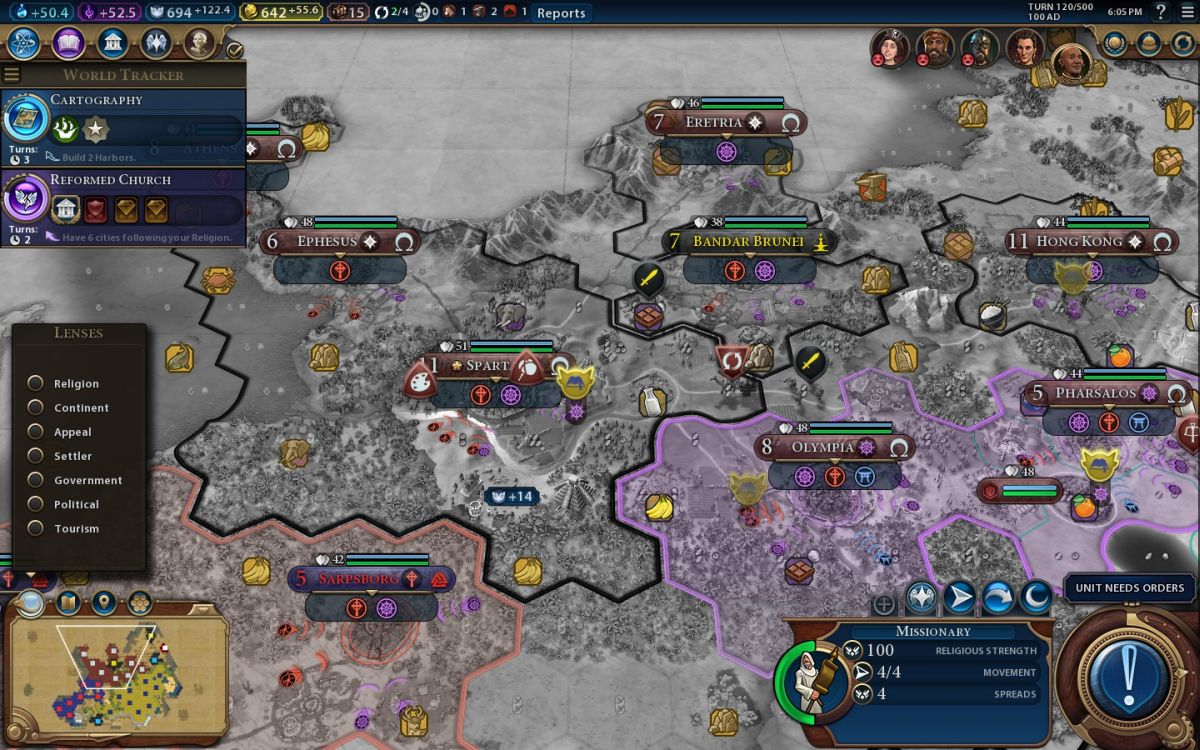
This was an overview of Gorgo's territory as of Turn 120 using the religious lens. It was highly useful to see at a glance which cities had formally converted to Buddhism and which ones still needed more nudging along with my missionaries. The new interface makes it very clear how the passive spread mechanics of religion work, and why it's useful to spread your religion as much as possible. For example, it was worthwhile to use a few missionary charges on the city state of Bandar Brunei to ensure that it would convert and then keep pressuring all of the cities around it. The religious lens also indicates sources of faith on the map, demonstrating where the AI civs have constructed their own Holy Sites and therefore which locations are the most important ones to target. I had launched my first missionary offensive into Greece, which was a relatively low pressure zone for religion since Gorgo lacked her own faith. I decided to go after Harald and his Catholicism next, and that would be a significantly more difficult task.
I finished researching Reformed Church civic on Turn 122 and adopted Theocracy as my government:

Theocracy is invariably the desired government for a religious game, between the bonus +5 strength for units that engage in religious combat and the 15% discount on all faith purchases. I used the Economic policy slots to pick up more faith generation with Scripture and Simultaneum, as well as slotting in Religious Orders later on after the round of builders that I was working on at the moment were completed. These policies and the many Khmer Holy Site districts transformed my empire into a religious powerhouse, with faith shooting up to almost 200 points per turn:
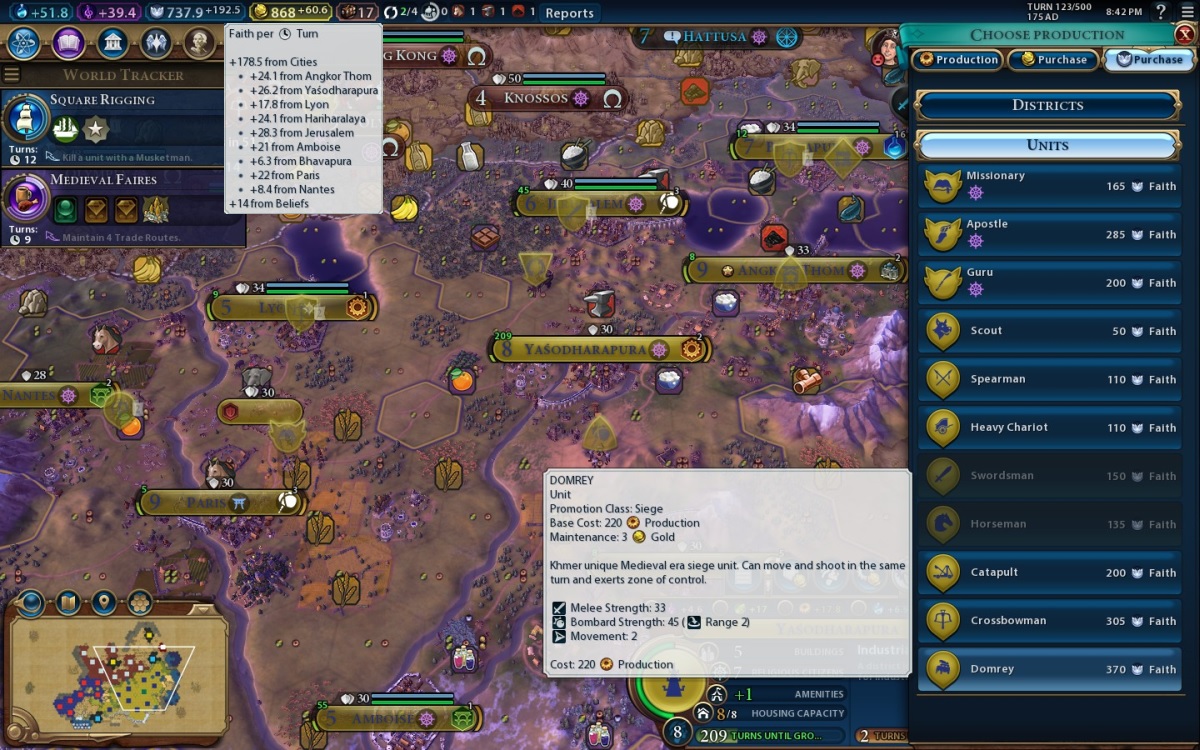
I appreciate the faith breakdown detailing exactly where these numbers were coming from. It's the kind of helpful mouseover tooltip that's often lacking in so many other parts of Civ6's interface design. Note that most cities capped out around 25 faith/turn, which was the reason that I needed to acquire more territory in the early stages of the game. One of the things that I love about Civ6's gameplay is the need for both horizontal and vertical expansion; the four city Tradition setups from Civ5 just aren't viable for fast finishes in this game. It's important to have more total cities so that more districts can keep getting constructed. I was a little bit disappointed that the Pilgrimage belief was only contributing 14 faith/turn; I had hoped for more there. Still, it was better than nothing, and it would continue to grow as I kept converting more followers in other lands.
Here's an underappreciated aspect of Theocracy as a government: the ability to purchase units with faith. Alhambram used this to good effect in the PBEM2 game with Russia, but otherwise we haven't seen too much of this in our Multiplayer events as yet. The unit costs in faith are quite cheap when running this government setup; I could have purchased a crossbow every other turn with the faith output that I was running here. Now with that said, I don't think a player could run a setup quite this faith-heavy in a Multiplayer game, and the Theocracy unit purchasing strategy wouldn't scale into the lategame once the units start getting really expensive. Still, I could easily see someone playing as Arabia or Russia and saving up a thousand faith and then suddenly swapping into Theocracy to rush out a nasty combination of horses and swords and crossbows. Or the player could be even more devious: faith-purchase a bunch of heavy chariots and then gold-upgrade them into knights en mass with Professional Army civic. This would be even scarier for Arabia with their Mamluke unique unit, yikes. Food for thought! I don't think we've done more than scratch the surface of Civ6 MP as yet.
In this game, my missionaries had gone through the process of converting the Greek cities with little in the way of response from Gorgo. When the same Buddhist missionaries arrived in Scandinavia, they were met with a much more hostile reception:

Harald did not sit back and let all his cities get converted without responding, as the AI chumps had done in my previous religious games. Instead, he immediately used an apostle to call for an Inquisition, and then his inquisitors began attacking my missionaries. This is where the changes to the religious mechanics in the Fall Patch again came to the forefront. Since religious units now have their own layer, they ignore normal combat units and those same combat units ignore them. (And thank goodness for that! Anyone remember images like this from the release version?) If this game were being played under the old system, those Viking knights and swords wouldn't even let my missionaries reach the city of Hamar. Conversely, religious units now exert zones of control with regards to other religious units, and the enemy inquisitors were blocking off access to the western side of the city. I hadn't been expecting Harald to do something as smart as this, and my missionaries were out here in an exposed position, unable to do anything other than run away for their lives. (Missionaries can't initiate combat, only apostles and inquisitors can do that.) One of these missionaries was killed before I could extract him, and the rest were forced to run back to my own territory. The AI was actually doing something smart for a change!
Well, mostly smart. The best thing to do would have been to burn some of the inquisitor charges to "remove heresy" and eliminate Buddhism from the city of Hamar. I found that the AI would occasionally do this with their inquisitors, although it didn't happen too frequently. Mostly the inquistors tried to hunt down and kill my religious units, not remove Buddhism from AI-controlled cities, and I was very thankful for that. On the rare occasions when they did use a charge to remove Buddhism, it always took a whole bunch of missionary charges to regain the lost ground. It's pretty much impossible to forcefully convert another civ that has inquisitors when the units are used correctly, since they're so much cheaper than apostles and fight at roughly the same strength within their home territory. Fortunately the AI doesn't know how to use these units properly, and that makes a religious victory a possibility.
One other note here about the religious lens: I did finally figure out how to get the "turns to convert" to show up. It turns out that this is the default state of the religious lens at the start of every turn, and any city that's in the process of converting will show those numbers at the start of each turn. However, doing anything with a religious unit, even something as simple as moving that unit, could cause the numbers to disappear. I suppose that the game engine only trusts itself to do these calculations between turns, and opts not to show any information once religious charges are getting flung about. That's the lesson then: look around before moving any units if you want to see this information.
Oh, and why the heck was Catholicism using a tiny little Confucianism icon on this screen to show religious pressure? Look closely at the terrain and you'll see it. Must be a very minor graphical bug. 

The war for the souls of the Scandinavian people was as intense as any that I've played against the AI in Civ6. Harald fought back against my missionaries at every turn, repeatedly training more inquisitors as we converted and reconverted cities back and forth. After my initial failed push when the first inquisitors showed up, I trained a pair of apostles and a guru, then sent my missionaries back again with these additional units for protection. Apostles are the offensive units in a religious game, able to initiate combat and start killing the missionaries and inquisitors of rival faiths. Gurus are a new religious support unit addded in the Fall Patch, and they have a very useful role to play as well. They do not engage in combat themselves, instead beginning with three charges that will heal all friendly religious units standing in the surrounding six tiles. That is incredibly helpful for sustaining a religious push since there is no other way to heal religious units in enemy territory. (Religious units can only heal normally by standing next to a Holy Site within your own territory.) I brought this guru along and he proved extremely helpful in sustaining the two apostles that were leading this invasion of Scandinavia. I highly suggest building gurus for any offensive gameplan involving religion, although they would be pretty useless if you're only defending your own territory and not trying to convert someone else.
One thing that was not helpful was the local geography in Harald's domains. The mountain range to the south of Tromso ran all the way down to the southern ice with no gaps or passes for units to move through. I had to circle past Skedsmo and Tromso from the north, or else head down to the very bottom of the map and sail through the icy waters in the antarctic. Furthermore, Tromso's location sat on a one-tile chokepoint, and even your religious units can't move through tiles controlled by enemy cities. Every unit that wanted to continue to the south had to embark on the ocean or the little lake in order to pass. What a pain in the rear. My Buddhist units forced their way through that little chokepoint with the religious equivalent of much blood and sweat. I did get a relic when one of my missionaries died, the first time that Reliquaries served any purpose all game long. That belief had been a bad choice.
Eventually my superior faith production and sheer weight of religious numbers wore down Harald. By Turn 144, Catholicism had been effectively wiped out:

Every Viking city was bathed in the soft purple glow of Buddhism. I had ultimately converted Bergen and Oslo by missionaries coming up from the south, as they sailed past on the water. One of the most important lessons I learned from my last religious game had been the fact that missionaries can expend their religious charges while embarked at sea, and that allowed several of my missionaries to convert these cities without having to fight the inquisitors that lurked on shore. My main offensive had eventually become stalled out near Nidaros, where the defending inquisitors kept getting healed on top of the city's Holy Site district. Fortunately I was able to convert the city itself and didn't need to push any further forward. Once all of the Viking cities had been converted, Harald's inquisitors stopped moving around and sat there inert. My fear was that they would use one of their charges to remove Buddhism from the local cities, and fortunately that never happened. Did they lose the ability to "remove heresy" once Harald's whole civ had converted to Buddhism? Or did their AI programming simply have no idea what to do in this situation? I honestly don't know. One of my major rivals had been defeated though, and now the two overseas Protestant AIs were the only ones left remaining.
While the Scandinavian campaign was underway, I had been teching to Cartography to unlock ocean movement and then sent out some old sword and horse units scouting, hoping to find the location of the remaining civs. It turned out that I had been exploring in the wrong direction; I went due east from my capital in the southern hemisphere, while both Victoria and Gilgamesh were located on a continent in the north. Eventually I stumbled upon the English city of Stoke-Upon-Trent and realized my mistake. This prompted me to check diplomacy with the two leaders again, and apparently my earlier warmonger penalty had run out because Gilgamesh was quite friendly with me. He was willing to sign a Friendship declaration, and then I suddenly realized that if we went a step further and signed an Alliance, I would have his whole map revealed to me. (And my map would be revealed to him, but that doesn't really matter with the AI.) Let there be light!

Suddenly the whole foreign continent appeared like magic, saving me from the time and effort needed to track down the location of all the remaining English and Sumerian cities. That was another small lesson I learned from all of the alliance-signing that's taken place in some of our Multiplayer games. The new map information revealed that the other continent was a fair bit smaller, with a huge desert region in the south-central portion that hadn't been settled by either of the two AI leaders. Victoria was surprisingly close to my homeland, located a short distance away to the northeast across the world wrap, and she had no self-founded religion or much faith production. She would be easy to bring into the Buddhist fold. Gilgamesh was a different story though. Not only was he the furthest leader away from me, he also seemed to be gunning for his own religious victory, with faith production well over 100/turn and with Holy Site districts (and Stonehenge) scattered across his empire. Converting him to Buddhism wasn't going to be easy, and I began gearing up for another major battle.
Gilgamesh's army was busying itself at the time by attacking a Militaristic city state in the far northern tundra. Valetta had mountains on three sides and could only be attacked from a single tile, which had left Gilgamesh stymied with about 80% of his units sitting around unable to do anything. I'll actually give the AI a little bit of a pass here, since the tactical situation at Valetta was genuinely difficult to maneuver through. That said, it still looked pretty dumb to see ten Sumerican war carts twiddling their thumbs in the tundra while a single catapult chipped away at the defenses. One Unit Per Tile rules have not been kind to the Civilization AI.
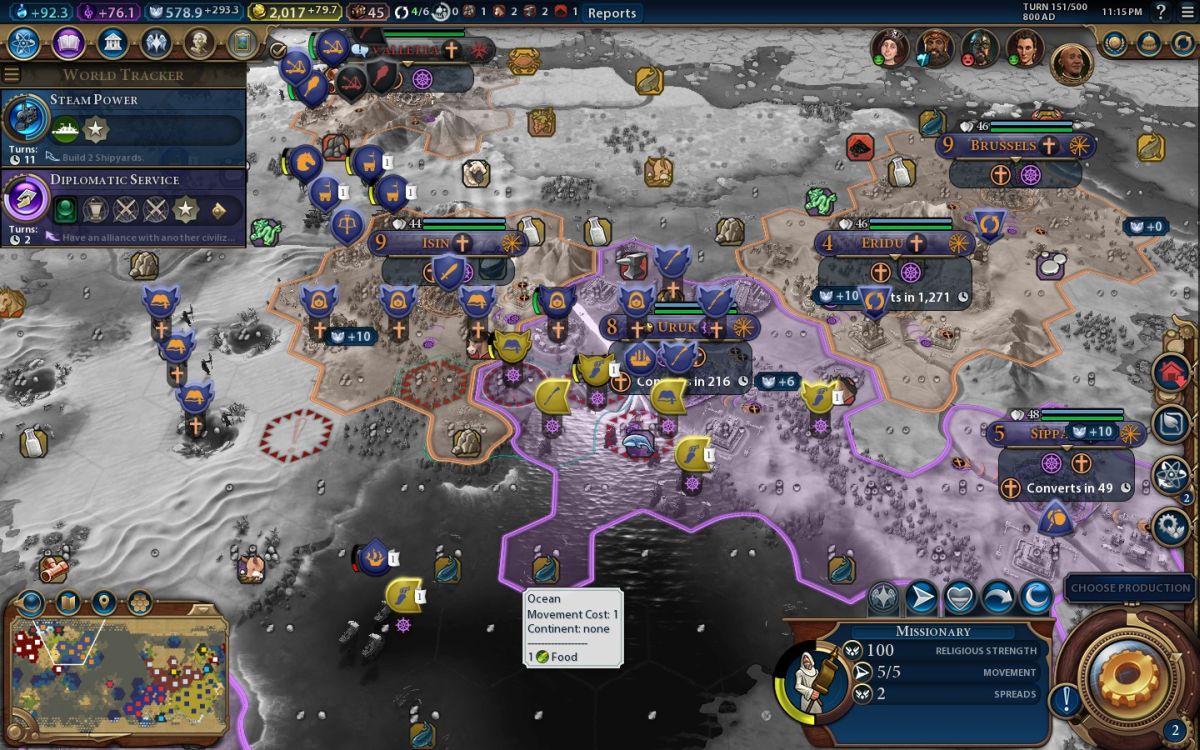
This was the scene when my religious armada finally arried at the borders of Sumeria. Uruk was an easy city to convert due to its coastal location, and my missionaries were able to get it to flip without much trouble. I even had one apostle with the Proselytizer promotion, which removed nearly all of the existing Protestant followers and set up the city to be replaced with Buddhists. (Note that this promotion has been nerfed from my last religious game, when it eliminated *ALL* religious followers of different religions. It now removes 75% of them, which is still downright amazing for conversions.) Gilgamesh responded to this threat by calling an Inquisition and then pumping out a wave of religious units. Just look at that display in the picture above: 4 inquisitors, 4 missionaries, and 3 gurus were all congregating in the area around Uruk and Isin. I had been able to convert Sippar while Gilgamesh was preparing his response, but that's where the easy part of this mission came to a halt.
The religious battle was soon joined:

I had initially wondered if it was possible for two civs that share an Alliance to engage in religious combat with one another. Ha! Well it didn't take long to discover an answer to that question. We clashed repeatedly over the following turns, as Gilgamesh threw his religious units against mine with reckless abandon. I had the numerical advantage, with nearly a dozen missionaries either in the area or in the process of arriving. Gilgamesh had the stronger units and the home turf advantage, however. I only had three apostles along with this task force, and while that might seem like a lot, the Sumerians already had four inquisitors just in the initial wave of units. I had to be very careful about where to fight the enemy religious units as well, since the inquisitors would heal most of the damage taken if they ended their turns next to one of Gilgamesh's Holy Site districts. Combined with the crazy logistics back to my home cities, this was not an easy tactical puzzle to work around. The one guru that I had on hand helped a lot, and I would have gladly traded a missionary or two for more of them. Those three healing charges ran out all too soon.
I was also trying to do everything possible to avoid losing any units in combat, Reliquaries belief or no Reliquaries. Whenever a religious unit died on either side, there was a big drop in the faith of that religion in the surrounding cities, and that was something to avoid at all costs. I was able to evacuate some of my redlined missionaries by embarking them on the water, or by using zone of control rules to scamper them away to safety. Gilgamesh naturally did no such thing, instead throwing his inquisitors against my units again and again in reckless fashion. I was getting the better of these trades and killing more units, but inevitably I did lose a missionary here and there. Given my overstretched supply lines, that was not a winning strategy in the long run. I needed to win with what I had right here, because I had diverted a wave of missionaries to convert England, and the next group of reinforcements were a good dozen turns away. Fortunately Gilgamesh only used his inquisitors to "remove heresy" twice, and both times in Uruk where I had plenty of missionaries on hand to convert the city right back again. The religious fortunes of the Sumerican capital swung back and forth between Protestantism and Buddhism again and again as we continued this clash of faiths.
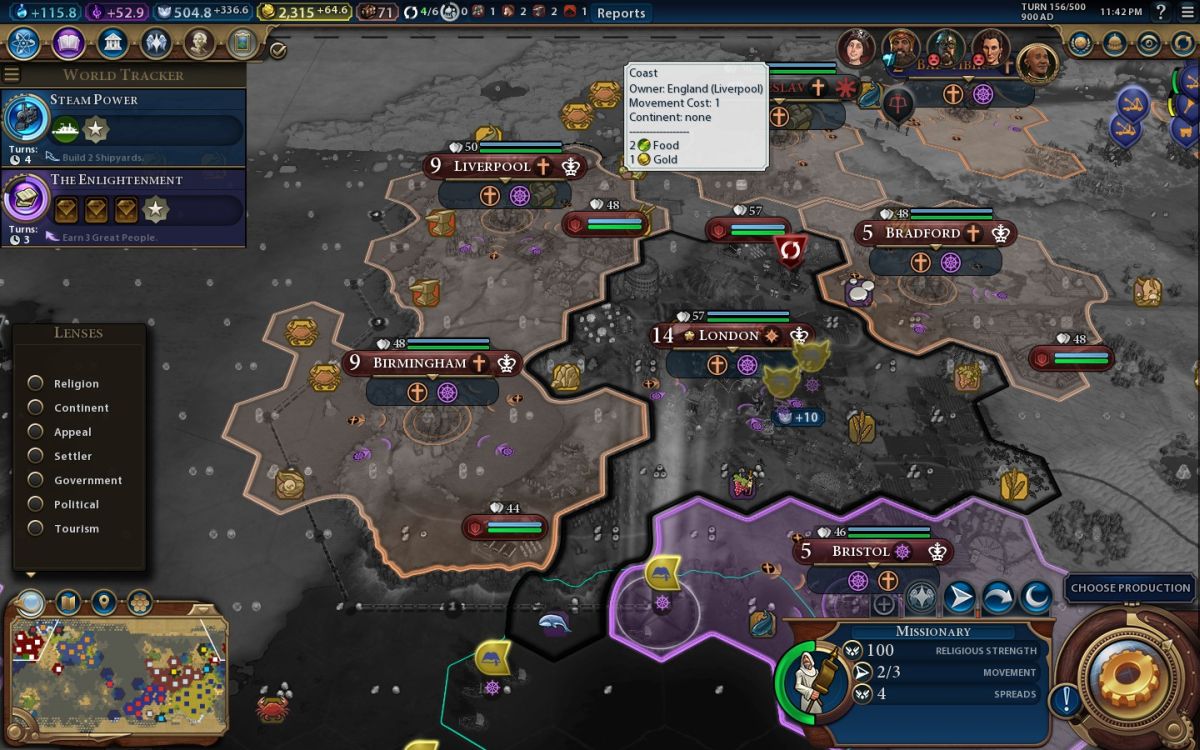
Meanwhile, the task was much smoother sailing over in England. Although all of Victoria's cities were Protestant, she had only a single Holy Site district in her empire, and she made no attempt to push back against my attempts to convert her to Buddhism. This is an area where Firaxis has made major strides in making the AIs play different from one another. Harald and Gilgamesh were both very focused on religion and fought back against my religious victory; Gorgo and Victoria didn't particularly seem to care and emphasized other parts of the gameplay (military and gold respectively). This is a very positive development for the gameplay, and I'm looking forward to exploring how some of the different AIs choose different strategic paths in future games. Oh, one other thing I'll point out in this screenshot: there was a ridiculous cliff that extended from Bristol all the way around Birmingham and Liverpool up to Preslav. I could not disembark units anywhere along that shoreline, which meant that most of the missionaries were entering English territory via the port at Bristol. One thing that I could do was convert Birmingham and Liverpool from the sea without disembarking my missionaries, and the next group of them would head up in that direction to start working on that goal.
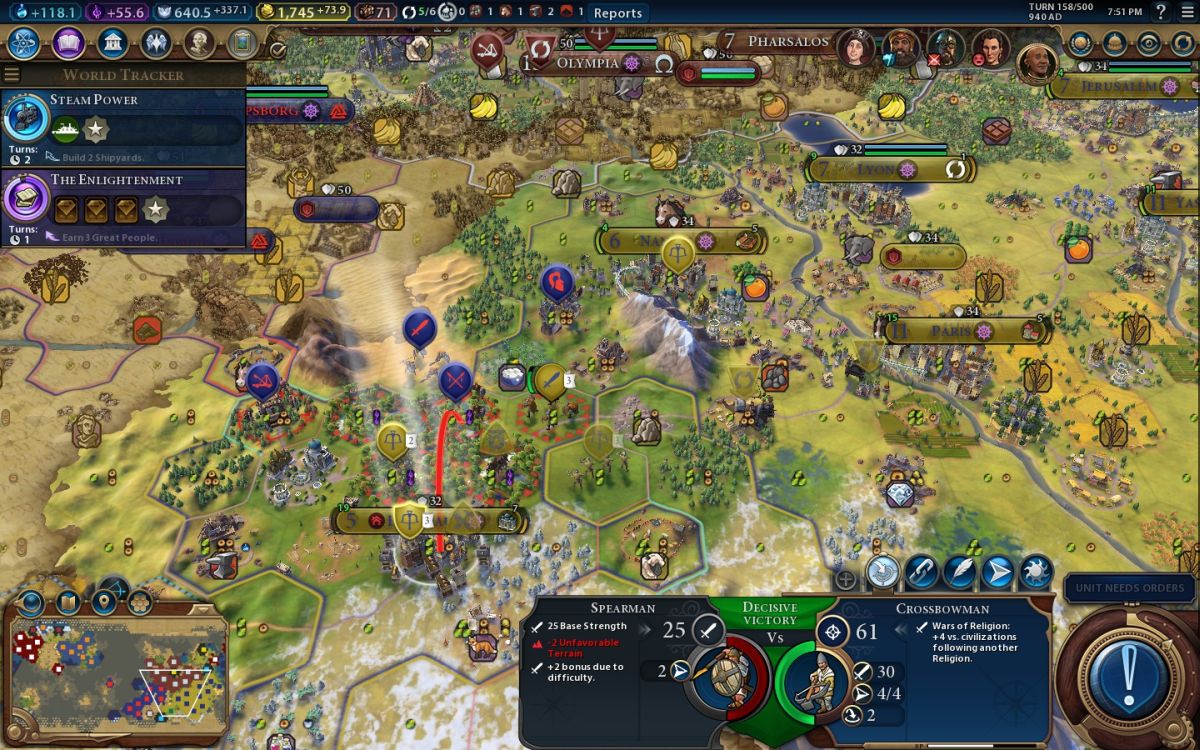
Great, just what I needed right now while my religious units were fighting over in Sumeria: a non-religious war with Harald.  Relations had plunged off a cliff from our earlier cordial status once I started converting the Viking cities, and now that the Declaration of Friendship had worn off, they were coming to extract some revenge. Harald was actually #1 in military power, with a score of 927 to the roughly 300 that my empire had. However, this was another war that the AI had telegraphed in advance, and I had shifted some crossbows and swords over to the western frontline cities in anticipation of an attack. Most of my crossbows were highly promoted - these were the same units that had been fighting France on Turn 50 - and I had plenty of money to rushbuy some more units with the thousands of gold sitting unused in the bank. On top of that, I also had a Great General to buff my crossbows and I had even claimed the first Great Engineer a couple turns ago, the one that instantly rushes Ancient and Medieval walls in a city. They were about to go up in Bourdeaux on the next turn. Furthermore, most of Harald's military power was tied up in ships that couldn't reach any of my cities, and the units he did have on land were badly outclassed. My crossbows could one-shot his spears and catapults, with the knights and swords not faring much better. In other words, this little war posed no threat at all, and mostly gave my combat units something to do for fun and training.
Relations had plunged off a cliff from our earlier cordial status once I started converting the Viking cities, and now that the Declaration of Friendship had worn off, they were coming to extract some revenge. Harald was actually #1 in military power, with a score of 927 to the roughly 300 that my empire had. However, this was another war that the AI had telegraphed in advance, and I had shifted some crossbows and swords over to the western frontline cities in anticipation of an attack. Most of my crossbows were highly promoted - these were the same units that had been fighting France on Turn 50 - and I had plenty of money to rushbuy some more units with the thousands of gold sitting unused in the bank. On top of that, I also had a Great General to buff my crossbows and I had even claimed the first Great Engineer a couple turns ago, the one that instantly rushes Ancient and Medieval walls in a city. They were about to go up in Bourdeaux on the next turn. Furthermore, most of Harald's military power was tied up in ships that couldn't reach any of my cities, and the units he did have on land were badly outclassed. My crossbows could one-shot his spears and catapults, with the knights and swords not faring much better. In other words, this little war posed no threat at all, and mostly gave my combat units something to do for fun and training.
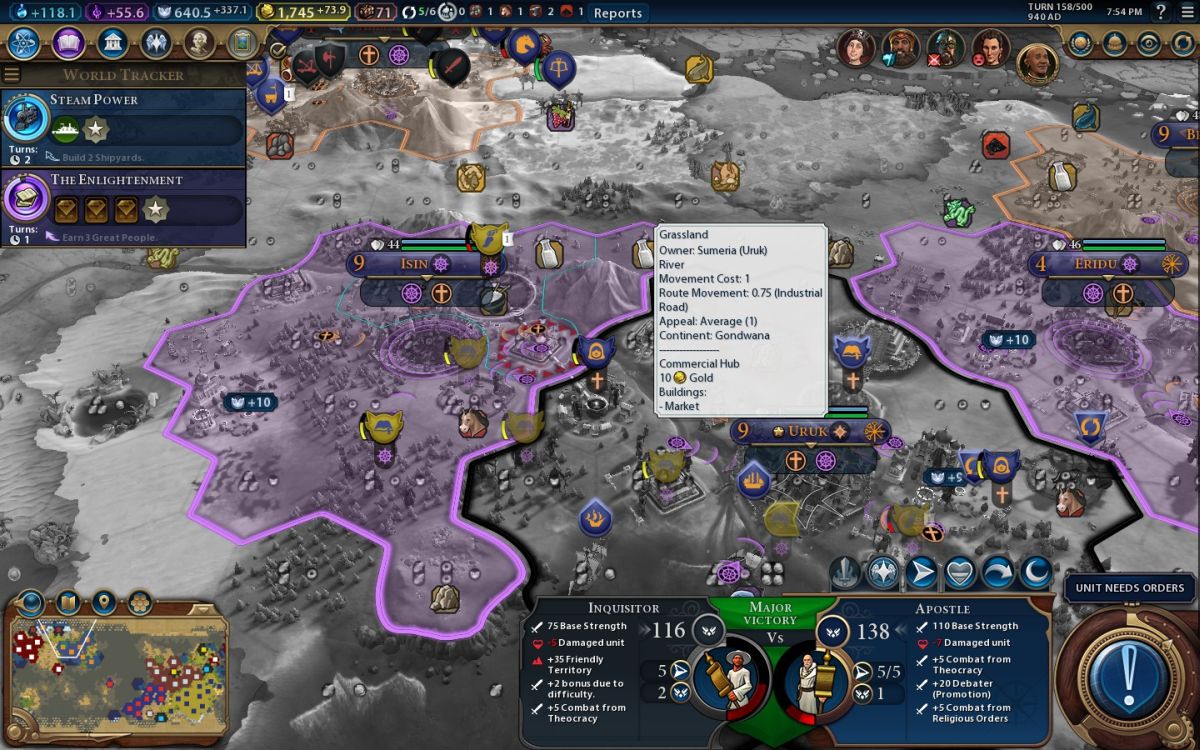
Over in Sumeria, the religious struggle continued to grind onwards. Gilgamesh had been pushing forward towards Uruk with his inquisitors and missionaries, enough so that I was able to land missionaries to the south of Isin and slip behind the city to convert it. Uruk itself had swung back and forth repeatedly between religions; at the moment it was following neither religion. I was hoping to flip it back to Buddhism, and if I could hold the city and then convert one or two more Sumerian cities, I thought that would be enough to secure a victory over here. A lot of my units were pretty beat up though, and I could have used another guru in the worst way. (The AI-controlled gurus never seemed to do anything; they probably disappeared when they used their one "spread religion" charge.) My best unit in combat was this apostle with the Debater promotion, the one that adds +20 to combat strength when facing other religious units. This guy was heavily damaged but still had enough health left to kill this Sumerian inquisitor, who I had successfully been baiting into attacking my nearby missionaries over the last two turns. I made the attack and...
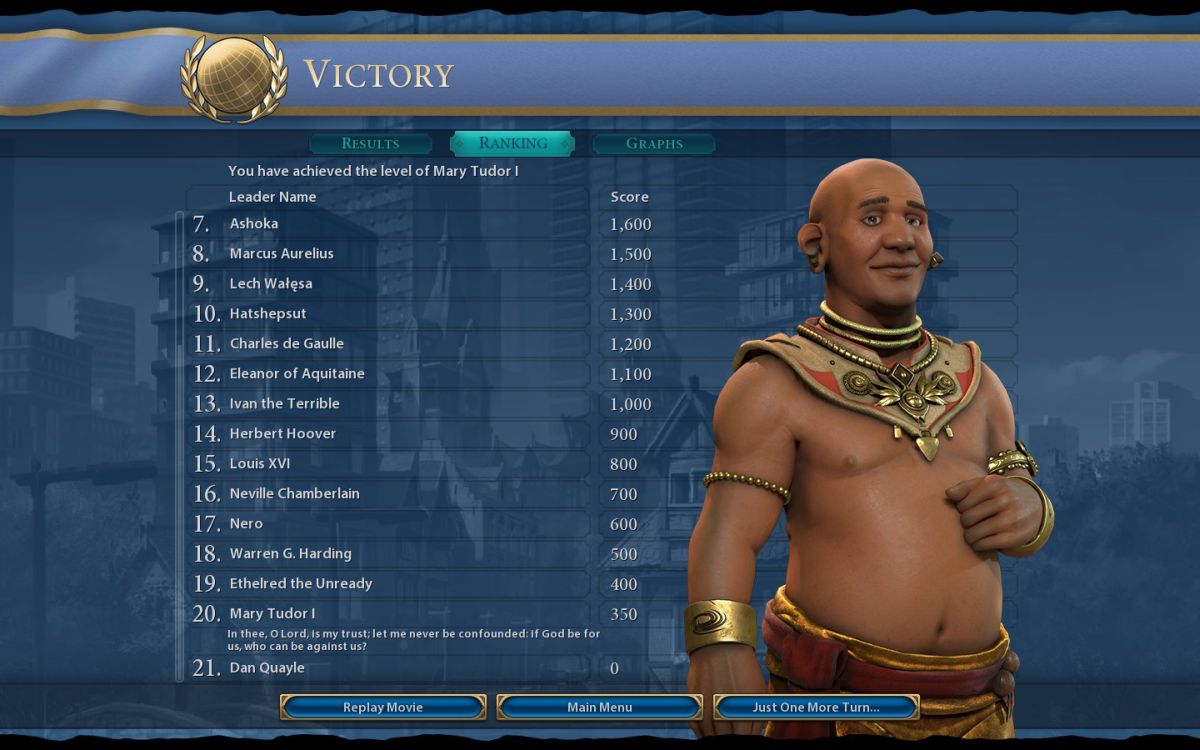
Religious victory?!  Where the heck did that come from? I knew I had been making some good progress, but I thought I still had a good bit more work to do before converting Victoria and Gilgamesh over to my faith. I guess that's a testament to the power of killing an enemy unit in religious combat, as it dropped the Protestant worshippers in the immediate area enough for my Buddhism to become dominant and put me over the top. It was complete and total dumb luck that I had screenshotted that combat right before the game ended - that wasn't an image I went back and took retroactively. Turn 158 Religious Victory on Emperor difficulty, not bad at all. (Unfortunately, I also see that the victory ranking screen still assigns score equal to the ending in-game score, with no bonus for higher difficulty or faster finishes. Winning a pre-1000 AD victory on Emperor results in the second-lowest ranking, blah. I guess this screen is just going to be left broken forever? Whatever.)
Where the heck did that come from? I knew I had been making some good progress, but I thought I still had a good bit more work to do before converting Victoria and Gilgamesh over to my faith. I guess that's a testament to the power of killing an enemy unit in religious combat, as it dropped the Protestant worshippers in the immediate area enough for my Buddhism to become dominant and put me over the top. It was complete and total dumb luck that I had screenshotted that combat right before the game ended - that wasn't an image I went back and took retroactively. Turn 158 Religious Victory on Emperor difficulty, not bad at all. (Unfortunately, I also see that the victory ranking screen still assigns score equal to the ending in-game score, with no bonus for higher difficulty or faster finishes. Winning a pre-1000 AD victory on Emperor results in the second-lowest ranking, blah. I guess this screen is just going to be left broken forever? Whatever.)
I decided that I had to investigate the situation a bit more in the aftermath of this victory. I went ahead and picked the "Just One More Turn" option, and then took another look at the Sumerian front. This was especially confusing:
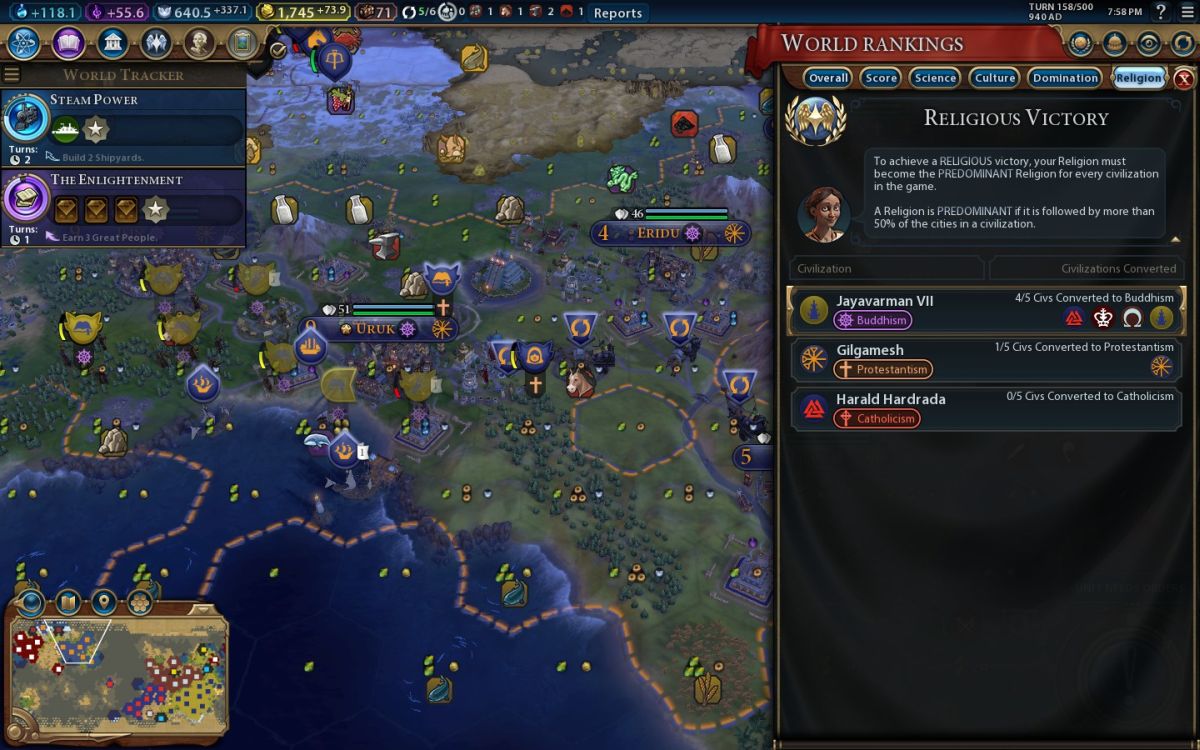
So it turns out that Gilgamesh didn't convert to Buddhism after all - huh?  Or maybe this screen stops updating once a victory condition is achieved, or maybe it doesn't update mid-turn. I'm afraid that I don't know exactly what happened here. While I wasn't complaining about the early victory, it did feel like there had been more yet to do over in Gilgamesh's territory. In the end though, I would have been able to finish off this win one way or another. My civ was pumping out 337 faith/turn, by far the most I've ever achieved in a religious game, and I was nearly done researching Steam Power for +2 movement on my embarked missionaries. I could alternate missionary/apostle, missionary/apostle every other turn, and with Steam Power in hand I would finally have enough movement points while embarked to reach the front lines quickly. It was ultimately just a matter of time.
Or maybe this screen stops updating once a victory condition is achieved, or maybe it doesn't update mid-turn. I'm afraid that I don't know exactly what happened here. While I wasn't complaining about the early victory, it did feel like there had been more yet to do over in Gilgamesh's territory. In the end though, I would have been able to finish off this win one way or another. My civ was pumping out 337 faith/turn, by far the most I've ever achieved in a religious game, and I was nearly done researching Steam Power for +2 movement on my embarked missionaries. I could alternate missionary/apostle, missionary/apostle every other turn, and with Steam Power in hand I would finally have enough movement points while embarked to reach the front lines quickly. It was ultimately just a matter of time.
This was a much more satisfying religious game than the first two that I played, and it was mostly due to the changed religious mechanics in this patch. The improved lens makes it enormously easier to tell what's going on, moving the religious units to their own layer solves all kinds of unit traffic jams, and the combat itself has been made more interesting through the addition of religious support units and zones of control. I'm intrigued enough that I might try some more of these games down the road, whereas before I felt like I never wanted to go through this victory type again. Civ6 is in a pretty good place with a year of patching now under its belt, and it's been gratifying to see increasing Multiplayer interest in the game from our community. If you can leave aside the terrible interface and the underwhelming (but improving!) AI performance, this is a fun game to play. Thanks for reading.



